Wood carving is an age-old art form that allows people to express creativity, build practical items, or even make beautiful sculptures. Whether you’re brand new to carving or already getting the hang of it, choosing the right type of wood can make all the difference. Some woods are softer, easier to cut, and better suited for learning. In this guide, we’ll break down the best woods for carving and help you find the perfect match—especially if you’re a beginner.
What Makes Wood Easy to Carve?
Not all wood is created equal when it comes to carving. Some woods are dense and tough, while others are light, soft, and a breeze to work with. The best wood for carving is typically soft, has a straight grain, and contains minimal knots. These qualities make it easier to control your tools and avoid splintering.
For beginners, carving wood should not feel like a struggle. Easy-to-carve wood gives you a smoother experience, allowing you to practice your technique instead of fighting the material. Factors like grain structure, wood hardness, and moisture content all play important roles. Woods with even grain and low hardness (measured by the Janka scale) are typically better for hand tools and whittling, while tougher hardwoods may be better for advanced projects.
Best Softwoods for Carving
Softwoods are popular with beginner wood carvers because they’re easier to work with. These woods come from coniferous trees and are generally lighter and softer. They are also more affordable and readily available in most areas, especially in the United States.
Some of the most popular softwoods for carving include:
- Basswood
- Pine
- Cedar
These woods are great for carving small projects, reliefs, and beginner sculptures. Softwoods also dull your tools less quickly, which makes them ideal for those who are still learning how to properly handle carving knives and chisels.
Basswood – A Carver’s Favorite
If you ask any experienced wood carver what the best wood for beginners is, they’ll likely say basswood. It’s often considered the gold standard for wood carving for beginners because it ticks all the boxes. Basswood is soft, light, and has a fine, even grain that’s perfect for detail work. It’s widely available in the U.S., often pre-cut in blocks at craft stores or lumberyards.
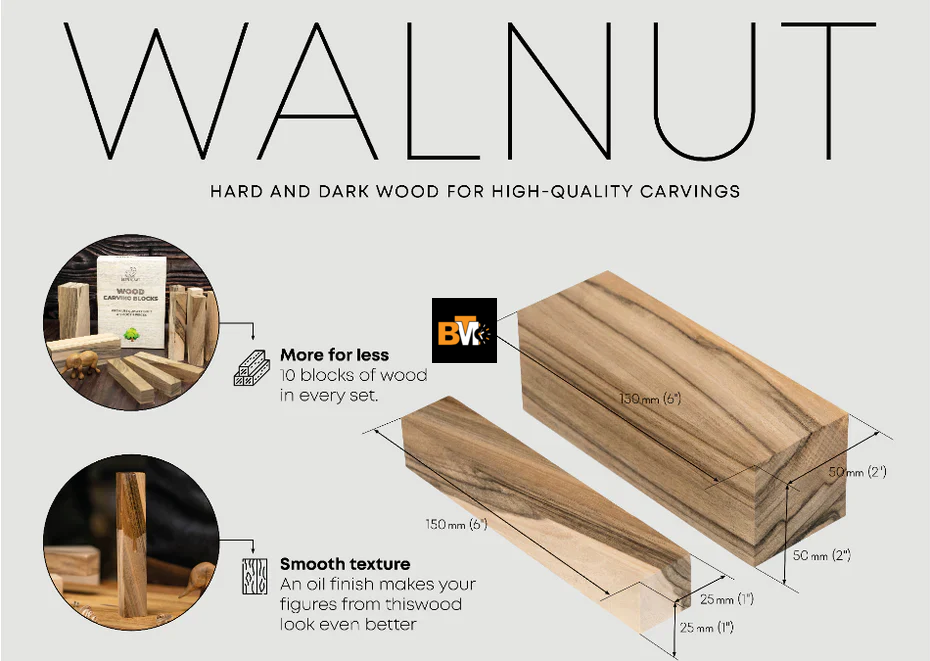
One of the best parts about basswood is that it doesn’t split easily. It’s forgiving, even when you make a mistake, and it won’t destroy your tools. Whether you’re doing chip carving, whittling, or relief carving, basswood is one of the most easy woods to carve and a top pick for hobbyists and professionals alike.
Pine – Easy and Cheap
Pine is another beginner-friendly wood that is affordable and accessible. You can find pine at any hardware store, and it comes in various forms like planks, blocks, and sheets. While it’s a little harder than basswood, it’s still quite soft compared to hardwoods and carves reasonably well.
Keep in mind that pine can sometimes contain knots, which are hard, resin-filled areas that can dull your tools. Choose knot-free pine if possible, and use sharp tools to reduce resistance. Pine is ideal for basic carving projects, signs, and practice pieces.
Cedar – Smells Nice, Carves Well
Cedar is a beautiful softwood that’s not only good for carving but also smells amazing. It has a rich reddish tone and is often used for decorative carvings, outdoor pieces, or wooden gifts. Cedar is relatively soft and carves well, though it can sometimes be brittle, depending on the grain.
It’s a popular choice for whittling and wood sculpture for beginners because it’s light and doesn’t strain your hands. Just make sure to wear a dust mask when sanding or cutting cedar—its fine dust can irritate your nose and lungs over time.
Best Hardwoods for Carving
Hardwoods are typically tougher and more durable than softwoods. They come from deciduous trees and are great for more advanced carvers or for projects that need to last a long time. If you’re aiming for fine detail or making functional items like bowls, spoons, or handles, hardwoods are the way to go.
But not all hardwoods are difficult to carve. Some are surprisingly easy to work with while still offering a beautiful finish. Two of the best are butternut and walnut.
Butternut – A Gentle Hardwood
If you want to step up from softwood to something a little stronger without jumping into tough, dense hardwood, butternut is the answer. It’s a light brown wood with a fine grain that’s very similar to basswood in feel, but with a slightly richer tone. Butternut is soft for a hardwood and very easy to carve with hand tools or chisels.
What makes butternut great for carving is its low density. It holds detail well and takes paint and stain beautifully, making it excellent for decorative projects and wood sculptures. It’s also more affordable than exotic hardwoods, so you can experiment without breaking the bank.
Walnut – Strong and Fancy
Walnut is one of the most luxurious woods you can carve. It’s rich, dark, and has a beautiful grain that makes any project look high-end. While walnut is a bit harder than basswood or butternut, it’s still considered one of the more carver-friendly hardwoods.
Walnut is great for both relief carving and 3D sculpture. Because it’s dense, it requires sharper tools and a little more effort, but the end result is worth it. You can polish it to a glossy finish or leave it natural to show off the deep grain. It’s perfect for keepsakes, gifts, or advanced carving projects.
Which Wood Should Beginners Use?
If you’re just starting out in wood carving, you’ll want to pick a wood that won’t fight back. The best choice is still basswood, thanks to its softness, availability, and clean grain. Pine and butternut are also excellent for beginners.
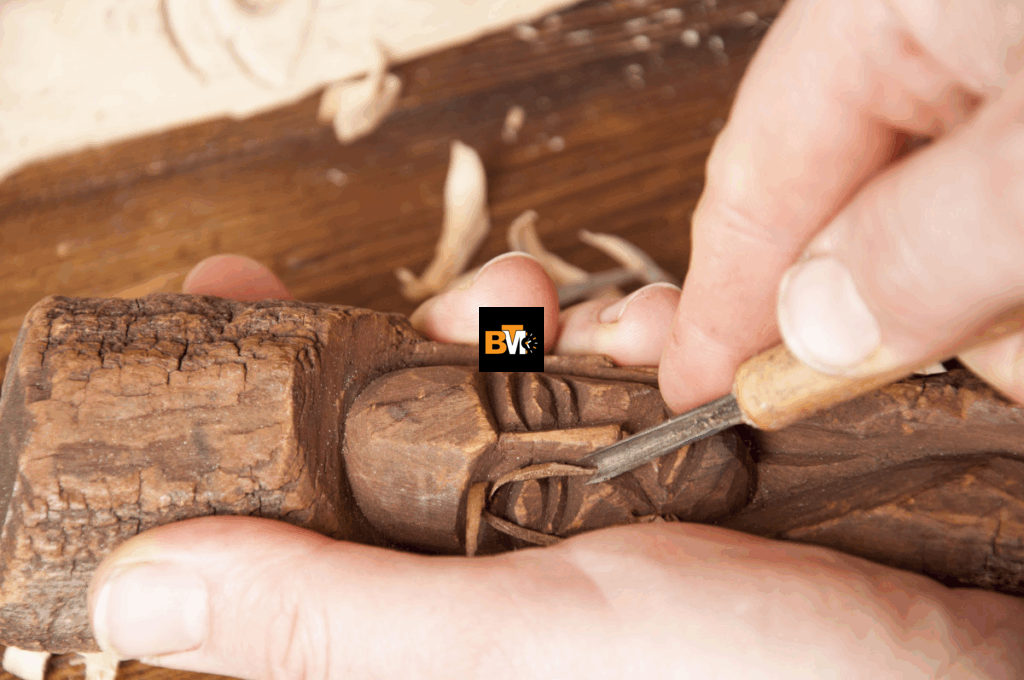
Try to avoid hardwoods like oak, maple, or mahogany when you’re starting. They are dense, tough, and can be discouraging if you’re not used to carving. Stick to easy woods that let you build skill and confidence.
Carving Tools for Different Wood Types
Different woods require different tools. For softwoods like basswood and pine, simple whittling knives, gouges, and chisels are enough. You can even get started with a basic carving knife and some sandpaper.
For hardwoods like walnut, you’ll need sharper tools, sometimes even power carving tools. Make sure to keep your blades sharp, no matter the wood—you’ll get cleaner cuts and safer results. Having the right tool for the wood type can make carving more enjoyable and help you create better-looking pieces.
Tips for Choosing Good Carving Wood
- Look for straight grain: Woods with straight, even grain are easier to carve and don’t splinter.
- Avoid knots: Knots are hard, unpredictable, and can damage your tools.
- Test the softness: Press your fingernail into the wood. If it leaves a mark, it’s soft enough to carve.
- Check moisture level: Slightly green wood is easier to carve but may crack when it dries. Dry wood is stable but harder.
- Buy from trusted sources: Choose wood from craft stores or lumber suppliers that sell to carvers.
Where to Find Wood for Carving
You can find carving wood in several places:
- Local craft stores: Great for basswood blocks and beginner kits.
- Lumberyards: Offer a wide variety of both hardwoods and softwoods.
- Online retailers: Websites like Amazon or specialty wood carving suppliers.
- Your backyard: For free wood, try using fallen branches from cedar, pine, or willow trees. Just make sure the wood is dry before carving.
Carving Tools for Different Wood Types
Using the right carving tools makes all the difference. For softwoods like basswood and pine, start with a basic whittling knife, bench knife, and a small set of gouges. You don’t need anything fancy to begin. For hardwoods like walnut and cherry, consider using mallet-driven chisels or even rotary tools to reduce strain on your hands. Keeping your tools razor-sharp is more important than the number of tools you have. A dull tool is dangerous and makes carving frustrating.
The Bottom Line
Carving is a relaxing and rewarding hobby, but it starts with choosing the right wood. For beginners, basswood is the best wood for carving—it’s soft, clean, and super easy to handle. If you want to try something different, pine, cedar, and butternut are also great. As you grow more confident, you can experiment with beautiful hardwoods like walnut.
No matter what type of wood you pick, always use sharp tools and be patient. With practice and the right material, you can turn a simple block of wood into a masterpiece.



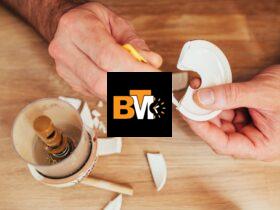

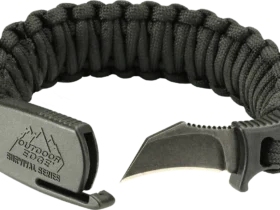
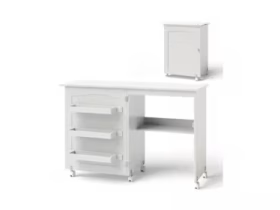
Leave a Reply